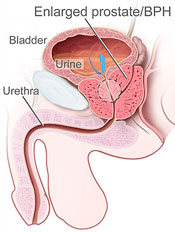Acupuncture combined with medication is superior to medication only for the treatment of an overactive bladder following prostate surgery. Researchers compared four treatment groups: acupuncture only, medication only, a control group and a group that received both acupuncture and medication. The researchers concluded that the combination of acupuncture with medication provided the most effective relief for an overactive bladder.
 Acupuncture Benefits ProstateAll subjects in the study had a transurethral resection of the prostate (TURP), an operation involving the removal of tissue by electrocautery or dissection. This urological operation is employed as a treatment for benign prostatic hyperplasia, an enlargement of the prostate that causes urinary tract infections, urinary retention, painful urination, frequent urination and urinary hesitancy.
Acupuncture Benefits ProstateAll subjects in the study had a transurethral resection of the prostate (TURP), an operation involving the removal of tissue by electrocautery or dissection. This urological operation is employed as a treatment for benign prostatic hyperplasia, an enlargement of the prostate that causes urinary tract infections, urinary retention, painful urination, frequent urination and urinary hesitancy.
Subjects in the medication only and combined acupuncture with medication groups were treated with tolterodine. Tolterodine is a muscarinic receptor antagonist used for the treatment of an overactive bladder. Subjects receiving acupuncture were administered electroacupuncture at acupoints Huiyang (BL35), Ciliao (BL32), Qugu (CV2) and Huiyin (CV1). Total treatment time ranged from five to seven days with acupuncture being administered once per day for thirty minutes.
There was no significant clinical difference in bladder overactivity between the medication only and the acupuncture only groups. However, the group receiving both medication and acupuncture had a marked improvement over the other groups. The researchers concluded that electroacupuncture combined with tolterodine is a clinically superior approach for the treatment of an overactive bladder following prostate surgery.
Reference:
Zhongguo Zhen Jiu. 2012 May;32(5):404-8. Overactive bladder after transurethral resection of prostate treated with electroacupuncture therapy and tolterodine. Shen YZ, Lin X, Lin Q.

